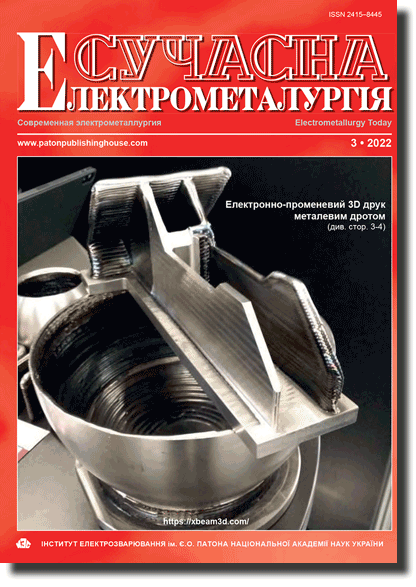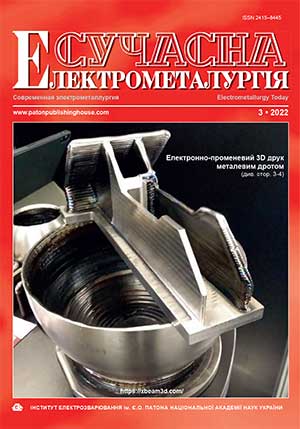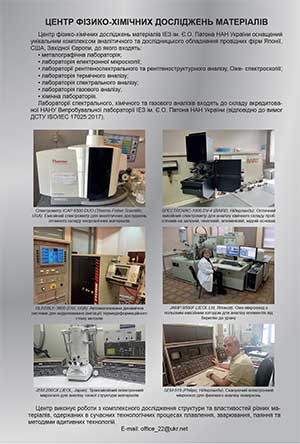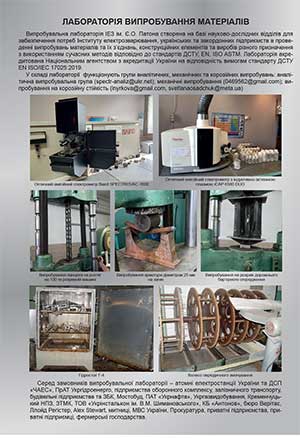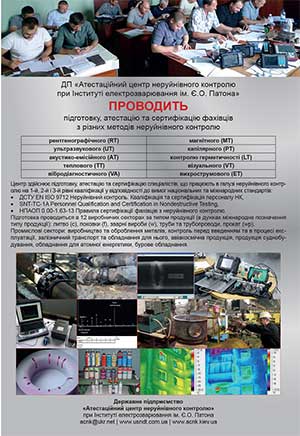| 2022 №03 (06) |
DOI of Article 10.37434/sem2022.03.07 |
2022 №03 (08) |
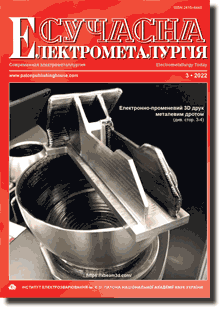
"Suchasna Elektrometallurgiya" (Electrometallurgy Today), 2022, #3, 44-52 pages
Influence of Al–Si AND Al–Cu multilayer on the formation of the joint structure of SiCР–АМг5 composite during diffusion welding
A.I. Ustinov, T.V. Melnychenko, Yu.V. Falchenko, L.V. Petrushinets
E.O. Paton Electric Welding Institute of the NAS of Ukraine. 11 Kazymyr Malevych Str., Kyiv, 03150, Ukraine. E-mail: office@paton.kiev.ua
Abstract
The regularities of joint structure formation in diffusion pressure welding through multilayer interlayers based on Al–Si and Al–Cu aluminum systems with eutectic, obtained by electron beam deposition in vacuum, were studied, using SiCp–AMg5 aluminum composite, as an example. It is shown that the intermediate multilayer layers of eutectic composition provide permanent joints without degradation of the properties of the base material at a temperature of 500 °C, which corresponds to the beginning of intensive plastic deformation of the interlayer under pressure. It is established that the nature of the diffusion interaction of the components of the interlayer and the composite and the phase composition of the eutectic affect the structure and the chemical composition of the joint. Conditions that prevent the formation of barrier layers at the interlayer/composite interface, namely layer alloying or intermetallic particle formation in it before the welding process, promote intensive mass transfer of interlayer and composite components, ensuring homogeneity of the structure and microhardness of the joint. Mechanisms for forming SiCp–AMg5 composite joint through multilayer intermediate layers based on aluminum systems with eutectic of different types — simple, consisting of system components (for example Al–Si) and one containing an intermetallic based on components (for example Al–Cu) are proposed. Ref. 18, Tabl. 3, Fig. 9.
Keywords: multilayer foil; EB-PVD; composite; diffusion welding; joint; microstructure
Received 22.06.2022
References
1. Lean, P.P., Gil, L., Urera, A. (2003) Dissimilar welds between unreinforced AA6082 and AA6092/SiC/25p composite by pulsed-MIG arc welding using unreinforced filler alloys (Al- 5Mg and Al-5Si). J. Materials Proc. Technology, 143-144, 846-850. https://doi.org/10.1016/S0924-0136(03)00331-52. Ureña, A., Escalera, M. D., Gil, L. (2000) Influence of interface reactions on fracture mechanisms in TIG arc-welded aluminium matrix composites. Composites Sci. and Technology, 60(4), 613−622. https://doi.org/10.1016/S0266-3538(99)00168-2
3. Carotenuto, G., Gallo, A., Nicolais, L. (1994) Degradation of SiC particles in aluminium-based composites. J. of Materials Sci., 29(19), 4967−4974. https://doi.org/10.1007/BF01151086
4. Urena, A., Rodrigo, P., Gil, L. (2001) Interfacial reactions in an Al-Cu-Mg (2009)/SiCw composite during liquid processing (Pt II): Arc welding. Ibid., 36, 429-439.
5. Muratoğlu, M., Yilmaz, O., Aksoy, M. (2006) Investigation on diffusion bonding characteristics of aluminum metal matrix composites (Al/SiCp) with pure aluminum for different heat treatments. J. of Materials Proc. Technology, 178(1−3), 211−217. https://doi.org/10.1016/j.jmatprotec.2006.03.168
6. Midling, O.T., Grong, F. (1994) A process model for friction welding of Al-Mg-Si alloys and Al-SiC metal matrix composite-I. Acta Metallurgica, 42(5), 1595-1599. https://doi.org/10.1016/0956-7151(94)90369-7
7. Midling, O.T, Grong, F. (1994) A process model for friction welding of Al-Mg-Si alloys and Al-SiC metal matrix composites-II. HAZ microstructure and strength evolution. Ibid., 1611-1622. https://doi.org/10.1016/0956-7151(94)90370-0
8. Askew, J. R., Wide, J. F., Khan, T. I. (1998) Transient liquid phase bonding of 2124 aluminium metal matrix composite. Mater. Sci. and Technol., 14(9−10), 920−924. https://doi.org/10.1179/mst.1998.14.9-10.920
9. Ureña, A., Gil, L., Escriche, E. et al. (2001) High temperature soldering of SiC particulate aluminium matrix composites (series 2000) using Zn−Al fi ller alloys. Sci. and Technol. of Welding and Joining, 6(1), 1−11. https://doi.org/10.1179/136217101101538479
10. Wielage, B., Hoyev, I., Weis, S. (2007) Soldering aluminum matrix composites. Welding J., 86(3), 67−70.
11. Falchenko, Yu.V., Muravejnik, A.N., Kharchenko, G.K. et al. (2010) Pressure welding of micro-dispersed composite material AMg5 + 27 % Al2O3 with application of rapidly solidifi ed interlayer of eutectic alloy Al + 33 % Cu. The Paton Welding J., 2, 7-10.
12. Ishchenko, A.Ya., Falchenko, Yu.V., Ustinov, A.I. et al. (2007) Diffusion welding of fi nely-dispersed AMg5/27 % Al2O3 composite with application of nanolayered Ni/Al foil. Ibid., 7, 2-5.
13. Ustinov, A., Falchenko, Yu., Melnichenko, T. et al. (2013) Diffusion welding of aluminium alloy strengthened by Al2O3 particles through an Al/Cu multilayer foil. J. of Materials Proc. Technology, 213(4), 543-552. https://doi.org/10.1016/j.jmatprotec.2012.11.012
14. Ustinov, A.I., Melnychenko, T.V., Demchenkov, S.A. (2021) Structural mechanism of plastic deformation of Al/а−Si multilayer foils at heating under load. Mater. Sci. and Engin.: A, 810, 141030. https://doi.org/10.1016/j.msea.2021.141030
15. Ustinov, A.I., Melnichenko, T.V., Shishkin, A.E. (2011) Deformation behaviour of multilayered Al/Cu foils at heating under conditions of permanent external loadings. Metallophysics and Advanced Technologies, 33, 1415-1423 [in Russian].
16. Movchan, B.A. (2006) Inorganic materials and coatings produced by EBPVD. Surface Eng., 22(1), 35-46. https://doi.org/10.1179/174329406X85029
17. Zhang, D. (2011) Thermal barrier coatings prepared by electron beam physical vapor deposition (EB-PVD). Metals and Surface Engineering. Thermal Barrier Coatings. Woodhead Publishing, 3-24. https://doi.org/10.1533/9780857090829.1.3
18. Biswas, P., Patra, S., Mondal, M.K. (2018) Effects of Mn addition on microstructure and hardness of Al-12.6Si alloy. IOP Conference Series: Mater. Sci. and Engin., 338, 012043. https://doi.org/10.1088/1757-899X/338/1/012043
Advertising in this issue:
The cost of subscription/purchase order journals or individual articles
| Journal/Currency | Annual Set | 1 issue printed |
1 issue |
one article |
| TPWJ/USD | 384 $ | 32 $ | 26 $ | 13 $ |
| TPWJ/EUR | 348 € | 29 € | 24 € | 12 € |
| TPWJ/UAH | 7200 UAH | 600 UAH | 600 UAH | 280 UAH |
| AS/UAH | 1800 UAH | 300 UAH | 300 UAH | 150 UAH |
| AS/USD | 192 $ | 32 $ | 26 $ | 13 $ |
| AS/EUR | 180 € | 30 € | 25 € | 12 € |
| SEM/UAH | 1200 UAH | 300 UAH | 300 UAH | 150 UAH |
| SEM/USD | 128 $ | 32 $ | 26 $ | 13 $ |
| SEM/EUR | 120 € | 30 € | 25 € | 12 € |
| TDNK/UAH | 1200 UAH | 300 UAH | 300 UAH | 150 UAH |
| TDNK/USD | 128 $ | 32 $ | 26 $ | 13 $ |
| TDNK/EUR | 120 € | 30 € | 25 € | 15 € |
AS = «Automatic Welding» - 6 issues per year;
TPWJ = «PATON WELDING JOURNAL» - 12 issues per year;
SEM = «Electrometallurgy Today» - 4 issues per year;
TDNK = «Technical Diagnostics and Non-Destructive Testing» - 4 issues per year.





